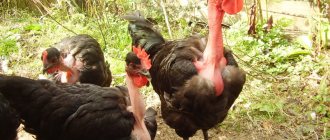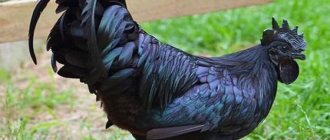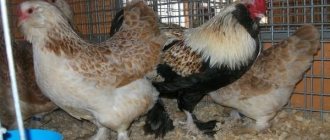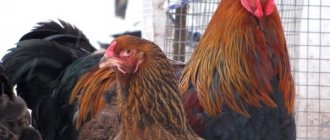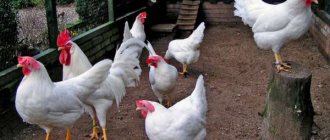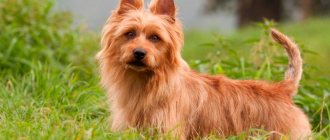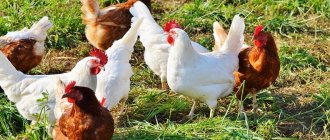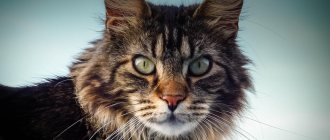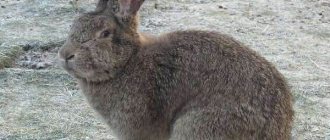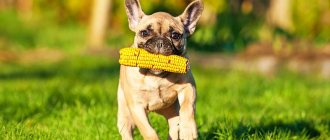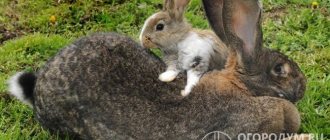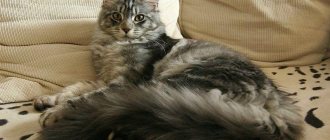The Jersey Giant is a unique breed of chickens, the representatives of which are real giants. Among meat poultry breeds, this species has received a special place. Jerseyans are record holders and are considered the largest birds on our planet. Chickens can weigh up to 7 kg, are hardy and resilient, and are very popular on private farms.
Description of the breed
Photo:
Graceful posture, large size, power, and high legs are the distinctive features of the Jersey giant. The breed has 3 main colors: blue-black, snow-white and edged ash-blue. The traditional color is black; the appearance of blue was facilitated by the work of German breeders.
Chickens of this breed have interesting legs: superbly developed, muscular, widely set, stable, with large shins and thighs. Jersey giant chickens have four toes.
Their legs and metatarsals range in color from gray to completely black. The color of the paws and the color of the beak are influenced by the main color of the bird: in black individuals these parts are completely black, in white individuals they are yellow with dark streaks.
The blue-edged Jersey Giant chickens have a black beak with a slight yellowish tint and the same colored paws. The tips of the fingers and the lower surface of the legs have a lighter shade.
Roosters are characterized by a large, wide head with a vertically positioned six-toothed leaf-shaped comb. The lobes are medium-sized, smoothly rounded, without the wrinkles characteristic of most chickens. The comb and lobes of the Jersey giant are bright scarlet.
The beak is strong, curved, and short. The convex round dark brown, almost black, eyes of the bird are quite large in size. The head is connected to the body by a well-feathered, strong neck.
The horizontal long body is slightly reminiscent of broiler rearing. The admiring glances of true connoisseurs of birds are attracted by their full, deep chest, muscular shoulders, wide backs, and well-developed belly.
A magnificent decoration of the bird is its rather large and thick tail, located at an angle of 45° relative to the back, formed by sickle-shaped feathers.
The long and wide tail wings of the feathers are tightly adjacent to the sides. They are covered by braids located on top. The dense and smooth main plumage covers the yellow skin.
Chickens, with the exception of sexual differences, differ little in appearance from roosters. These beauties are slightly shorter, more squat, unlike chickens of other breeds, and have a luxurious tail, located lower and more magnificent than that of roosters.
Official recognition
The Jersey or Jersey chicken breed was officially registered in 1922.
English breeders became interested in the prospects for the breed's development, which prompted further work on improving the Jerseys. The characteristic color of the first purebred giants remained black, but as a result of selection, blue Jersey chickens were bred in Britain, and white Jersey chickens were bred in Germany.
The breed of giant laying hens began to be raised in German and Dutch farms, after which massive chickens spread throughout European territory. Birds are not in demand in our country; only amateurs raise Jersey giant chickens.
Origin story
The Jersey Giant is a breed of meat-egg chicken created by American farmers in the twenties of the last century, which was bred by crossing Langshan, Brahma and Orlington.
The efforts of enthusiasts to purposefully crossbreed different breeds of dark-colored chickens have led to the creation of a very successful stable breed.
The Jersey giant, which appeared in central Russia, created a real sensation among poultry farmers: the live weight of roosters reaches 6-7 kilograms, laying hens weigh on average 4 kilograms.
Productive characteristics
The Jersey giant grows very quickly; by one year the roosters already weigh 5 kg. The most active growth occurs in the first five months, then daily weight gain decreases and maintaining young beef stock becomes unprofitable.
Jersey chickens left for breeding lay their first eggs at the age of 6-8 months with a body weight of 3.6 kg. A fully grown Jersey laying hen weighs a kilogram more. For a meat breed, the Jersey giant has very good egg production rates: 170 eggs weighing 70 g per year. Jersey giant eggs have brown shells. With quality feeding, it is strong.
Price
The Jersey Giant is a fairly rare breed for Russia and is in constant demand. Due to this, the cost of a hatching egg is not cheap: about 300 rubles without delivery.
An egg can be considered incubatory a month after the first laying. It is not worth increasing the number of roosters in the herd to increase the fertility of eggs to 100%. An excessive number of them, on the contrary, can cause harm. By competing, roosters can interfere with each other.
Excessive covering causes physical problems for hens: feathers are pulled out from the backs of weaker hens by heavy roosters. Such activity of flock leaders should be under the supervision of the poultry farmer.
If “bald patches” and wounds are found in the back area of the chickens’ plumage, it is recommended to wear special blankets on them, which will provide protection during “love games”. The optimal ratio of males and females for the herd is 1:10.
To obtain high-quality hatching eggs, special attention should be paid to the weight of the representatives of the parent flock. Obese and overfed individuals are not suitable for this honorable mission.
Excessively heavy roosters and hens have difficulty mating, which can lead to decreased egg fertility. For this reason, several months before the start of collecting hatching eggs, it is recommended to limit the bird's feed intake in order to normalize its weight.
The parent herd must be separated from representatives of other breeds, otherwise the offspring may not be purebred. The Jersey giant has a weak brooding instinct, like other meat breeds.
When a hen starts working, she may crush some of the eggs due to her weight. In this regard, it is advisable to use an incubator.
Bird breeding as a business
If you plan to raise and breed birds of this breed to build a successful and profitable business, you need to take into account the following nuances:
- To raise chickens, use only highly productive, high-quality and expensive feed.
- At first, you will have to make a fairly impressive monetary contribution. If you approach business organization correctly, all investments will definitely pay off in the near future.
- Females are very large and clumsy, so they can crush eggs during incubation. To avoid this problem, use an incubator to produce chicks.
- The weight of an adult bird can be determined in advance from the egg.
- If necessary, you can calculate the mass of the young according to the following scheme - add 170 g of the weight of the chick to the mass of the egg.
- Select young animals no later than 10-11 hours after hatching.
Externally, eggs do not have any characteristic differences, so to start your own business you need to purchase them from reliable farmers. This technique will help you be confident in the purity of the breed.
Reviews from poultry farmers
The Jersey Giant chicken breed is loved by many poultry farmers who successfully breed it and leave their positive reviews.
Among the advantages of the breed are:
- good quality meat in large quantities;
- survival rate of young animals 82-85%;
- resistance to colds;
- rapid weight gain.
Among the few disadvantages of the breed, poultry farmers note an increased amount of feed and an increase in the housing area per individual.
Bird character
A huge advantage of this cross is that it is a fairly calm and balanced bird, despite its size. The Jersey giant is not a shy species, and therefore laying hens do not stop producing eggs even in stressful situations that would unsettle other breeds or hybrids.
Despite the same impressive size, chickens are quite active and do not tolerate being kept in limited conditions (for example, cages). The bird has no special ability to fly, so there is no need to be afraid that representatives of this cross will one day run away.
Productivity, egg production
In the first year of life, the bird gains most of its body weight, especially actively until 5 months. Chickens of the Jersey Giant breed grow up to 1.5 years, although the growth rate is gradually decreasing. For this reason, it is unprofitable to keep poultry intended for slaughter for longer than 5 months.
In the seventh month, at the beginning of egg production, the chicken’s weight reaches 4 kilograms. Cockerels at the age of one year weigh about 5 kilograms, at 1.5 years their weight reaches 6 kilograms. With age, a male can reach a weight of 7 kilograms, but this has a negative effect on his fertilization abilities.
Despite their large size, Jersey giants are distinguished by high egg production. The eggshell is brown and strong. Already at five months of age, a laying hen can lay her first egg, although this is the exception and not the rule. Basically, Jersey giant chickens begin laying eggs at 6-7 months.
The first eggs of young laying hens are small, weighing 55-56 grams. Their weight subsequently increases, reaching in some cases 68 grams. Despite the name of the breed, you should not expect giant eggs from laying hens.
Each year, one hen usually lays about 180 eggs, that is, each hen lays eggs on average once every couple of days. Interestingly, this process does not stop with the arrival of winter. Even in December and January, the most unfavorable months for egg production, poultry farmers note egg fertilization at 82%.
Where to buy and at what cost?
In our country, Jerseys are a very popular breed, as the birds have a large body weight, tasty and juicy meat, excellent taste of eggs and a beautiful appearance. Many farms breed this breed.
You can buy Jerseys:
- Nursery "Count's Nest", Nizhny Novgorod.
- “Chicken Yard”, Krasnodar region, Apsheronsk.
- Simbirev private household plot, Moscow region, village. Ivashkovo.
Average cost of representatives of this breed:
- young rooster - about 1500 rubles;
- laying hen - about 1000 rubles;
- chicken – about 250 rubles;
- hatching egg - about 200 rubles.
Breeding Jersey Giant chickens
Experienced poultry farmers note that in terms of weight parameters, Jerseys at the very beginning of life are not much different from the general mass of chickens. Birds require a lot of vitality to form a skeleton, which is what distinguishes individuals of this breed.
For this reason, it is important to maintain high levels of calcium in poultry diets.
Installing feeders with crushed limestone or sand in paddocks and pens helps maintain the necessary balance. A necessary supplement for digestion is small pebbles, especially if the bird eats unparboiled whole grains.
Chalk can be used as a source of calcium, but it cannot completely replace shell rock. In the digestive system, chalk tends to clump together, forming lumps and clogging the intestines. In some cases, this can lead to the death of chickens.
Walk
It is best to organize the maintenance of a herd of this breed in such a way that in warm weather they can freely walk around the pasture, catch insects, pick worms from the ground, collect small pebbles, and peck fresh grass.
This is not difficult to do, since giants do not like to fly due to their heavy weight and do not require a high fence.
With proper nutrition, keeping the Jersey giant in an enclosure will not do much harm, if the need arises. In a closed space, calm, peace-loving giants feel great. In this case, you just need to adhere to the planting rules: 1-2 individuals per square meter.
Winter conditions
Jersey residents endure Russian winters easily. When the temperature drops to -5°C, egg production does not decrease. In the room where the bird spends the night, the temperature should not fall below +5°C. It is optimal to keep chickens at a temperature of +10-+12°C.
The chicken coop must have bedding made of sunflower husks, straw or sawdust. To provide the birds with clean air, you need to ventilate the room in which the chickens spend most of their time.
Content specifics
The Jersey giant can adapt to being kept in close quarters, but its health in this case will leave much to be desired. When keeping chickens indoors, it is necessary to take care of well-designed exhaust ventilation, which will remove ammonia that accumulates in the floor area. Chickens love to roll around in the litter, and Jersey giants are no exception. This is where the ammonia released from decomposing droppings collects. If there are systematically high concentrations of ammonia in the premises, livestock mortality may begin.
Important! All chickens want to roost somewhere higher for the night, so given the clumsiness of the Jersey giant, it is necessary to lay soft bedding under the roost. In this case, the chicken, even if it falls, will not harm itself.
Jersey chickens tolerate Russian winters well and are able to roam in enclosures during the day. The aviary area for one Jersey chicken is 0.5-1 m.
Due to their large body weight, Jersey chickens do not fly (although it is not known whether Jersey chickens themselves know this), but it is better to fence the enclosure with a fairly high mesh or make it with a roof so that smaller breeds of chickens, which know for sure that they can fly, were unable to enter the enclosure of the Jersey giants.
Yes, this is what your enclosure will look like in reality instead of the advertising green grass with Jersey chickens walking on it.
Moreover, with the stated density of chickens per unit area of the enclosure, it will look like this in a maximum of a month.
To completely clear a plot of land from grass, insects and underground larvae with earthworms, it is enough to fence it and put chickens there. The population density of chickens depends on the time allowed for cleaning the area. One chicken per 50 m² will cope with the task in 2-3 months, if the area is not overgrown with weeds, and in six months, if it is necessary to destroy powerful plants. It is not recommended to leave chickens for a longer period; trees may also run out.
In fact, chickens really need to be given green grass and vegetables, but it is better to harvest it yourself and give it to them in an enclosure specially built for them, than to let them go in search of pasture.
Feeding
Jersey giants need to be fed 2-3 times a day, preferably with a wet mash of mixed feed. The best one for them is one consisting of fodder and coarse grains. It is especially useful to give this mash to birds at night, allowing them to eat to their heart's content and go to bed with their crops filled.
This feeding regimen helps to increase egg production and provides body weight gain. The dirt contained in mixed feed cleanses the esophagus.
Meat breeds of chickens should receive a balanced feed every day:
- 40% wheat;
- 40% corn;
- 10% shell rock, cake or meal, fortified supplements.
Chicken breeders who raised the Jersey giant speak of the adult bird as an excellent forager. During the spring-summer season, when you release a bird to pasture, you don’t have to worry about feeding it: Jerseys happily eat caterpillars, worms, ants, pebbles, and grass seeds.
This allows you to reduce the consumption of additional feed by almost 70%. When kept freely, birds do not require artificially produced vitamin supplements, which allows significant savings on their feeding.
Contents of laying hens
Regular production of eggs requires light, warmth and balanced feed. Particular attention should be paid to the presence of calcium in the diet of laying hens. A separate feeder must contain sand, shell rock, and crushed limestone.
Among all known breeds, Jersey giants are distinguished by their poise and calmness. This fact also has a positive effect on egg production: in the absence of stress, laying hens lay eggs stably and evenly.
The large weight of laying hens leads to the fact that they sometimes crush eggs that other hens have already laid in the nest, and can even throw them away.
The poultry farmer should do everything possible to prevent losses. More frequent collection of eggs does not guarantee complete safety of the clutches. To solve this problem, nests are specially equipped with a slope and a hole into which the egg is rolled out.
Diseases
Mycoplasmosis poses a danger to chickens. Birds become infected through airborne droplets and contact. Characterized by hoarse breathing, weight loss, and swollen eyelids. After recovery, laying hens remain carriers of infection, and the walls of the poultry house are difficult to disinfect.
Worm infestation - you absolutely cannot sell slaughtered poultry, because worms penetrate into the meat of chickens and are transmitted to humans.
Skin and feather parasites: chickens lose weight and feel restless. The herd is treated against lice eaters, containers with ash-sand mixtures are installed, and the premises are disinfected.
Regular inspection of the Jersey Giant herd will protect against the spread of diseases in the poultry yard. If the chicken is weakened, does not approach the feeder, or discharge appears from the sinuses of the beak, you should consult a veterinarian.
Caring for young animals
If there is insufficient calcium and protein in the chickens’ diet, their growth slows down, they get sick and even die. Young animals that have not received enough vitamins A, D, and E at the time of active growth “sit on their paws.” It is quite difficult to get him out of this state. A chicken that has recovered from the disease will no longer be able to become a breeding bird.
Hatched chicks are placed in a warm place with a temperature range of +26-+28°C. Drafts and high humidity are detrimental to babies. It is recommended to use wheat bran or dry feed for bedding.
A very weak chicken will prefer to sit rather than stand on its legs or run, so soft bedding will be just right for it. Even without getting up, he will be able to peck a few grains of feed.
Feeding the chickens
There is no need to worry if the chickens refuse to eat on the first day. This means that the chicken’s body has a sufficient amount of embryonic yolk, which will dissolve in the esophagus and be completely absorbed by the body, strengthening its immunity. There is no need to feed the chickens additionally on the first day, but they do need to be given water.
The water temperature in the drinking bowl should be about +50°C. It is also recommended to add glucose and vitamin C to it. Do not forget that for chickens at the very beginning of their lives, cold water can be destructive. It is necessary to constantly monitor the cleanliness of the drink: droppings in it can cause poisoning.
Experienced chicken breeders do not recommend placing the brood in a closed box for the whole day, providing it with access to light and heat. It is recommended to feed chickens up to 6 times a day. For the first few days, you need to give them boiled and finely chopped chicken yolk, then switch to a feed mixture specialized for chickens.
After chickens are 3 days old, eggs should not be given.
It is very useful to feed them crushed corn and wheat, boiled millet, and natural fresh non-sour cottage cheese. The porridge must be filtered through cheesecloth so that the cereal is crumbly and does not stick together, otherwise babies may suffocate if it gets into the nostrils.
Natural vitamin supplements in the form of clover, nettle, and alfalfa can be included in the chickens’ diet on the third day. It is recommended to mix chopped greens with feed or grain mash.
From a week of age, chickens should gradually begin to receive boiled potatoes and carrots. It is also recommended to add root vegetables to the mash. Fish oil is added to morning meals to strengthen the immune system.
“Growth acceleration” in young Jersey giant animals begins at the age of 2.5-3 months. At this time, special attention should be paid to the amount of protein in their diet.
Adding barley, legumes, dairy products, boiled meat and fish, soaked or fresh bread to the mash will help the bird gain the required weight. Vitamin supplements - chopped herbs and vegetables - are given in unlimited quantities during this period.
Nutrition for teenagers
After reaching two months of age, the bird is transferred to an adult diet. Cockerels designated for slaughter receive increased nutrition in the following months. The growth spurt that occurs at this time ensures the output of marketable products by 5 months.
Protein nutrition is very important at this time, which can be easily provided by grazing from spring to autumn. That is why it is best to lay eggs for incubation at the end of winter.
Prevention measures
It is recommended to observe sanitary and hygienic standards in the poultry house, carry out vaccinations in a timely manner, not to purchase young animals on the market, and to exclude contact between poultry and wild birds.
Order is maintained in the poultry house and on the run. To prevent contact between chickens and other birds, cover the top of the enclosure with transparent film.
When walking, it is recommended to sow tall grasses and dig trenches, filling them with ash. Jersey giant hens will get rid of parasites on their own by bathing in improvised dust baths.
Diseases and their treatment
Jersey giants, like other chickens, suffer from mycoplasmosis. For the first 2 months, you need to carefully monitor the bird, especially those purchased from dubious sellers. It is recommended to first isolate newly acquired individuals from the general herd.
For a poultry farmer, feather eaters, fleas, parasites, and ticks can become a real scourge. These harmful insects are carried by wild birds, from which it is almost impossible to protect chickens when kept on pasture.
Folk remedies have proven themselves well in the fight against them. An excellent preventive measure is ash baths: chickens enjoy “bathing” in ash simply sprinkled on the ground or in a trough.
Special solutions that suppress parasites are sold in pharmacies. Bathing infected birds in them drives away the pests.
Advantages and disadvantages
Jersey giants have certain advantages, which include:
- the meat is tasty and juicy;
- high productivity;
- birds gain weight in a short time;
- eggs of excellent taste;
- easily adapt to different conditions;
- females become excellent brood hens;
- are practically not exposed to diseases;
- high survival rate.
Like any other breed, this species has some disadvantages:
- the birds are large, so they need a large area for walking;
- it is necessary to select a special diet, which will ensure the survival of the young;
- The taste of meat in birds older than 11 months decreases.
Birds of this breed often suffer from such an unpleasant disease as obesity. This may negatively affect the quality of eggs for hatching.
Characteristics, sexual maturity and onset of oviposition
Sexual maturity of Jersey giants begins at six months of age. Eggs for laying in the incubator are laid from the age of eight months.
How to find out how a particular chicken is laying: a bird that is laying eggs has a comb and lobes that look full and smooth, the belly is large and soft (not hard - like an overweight chicken). The skin under the wings is soft, velvety, and not covered with scales.
Adult roosters of the largest purebred chicken breed weigh up to 9 kg
There should be a distance of three fingers between the pubic bones, but if there are not even two fingers there, then the chicken will not lay eggs.
If you carefully look after your chickens, you won’t have to waste feed, and you’ll regularly have chicken on the table.
Some chickens lose their brooding instinct, so an outbred chicken can replace the hen.
Analogs
There are some other breeds that are somewhat similar to Jersey Giant chickens. For example, the breed of chicken is Australorp black. These chickens are quite large, they have a wide and long back, a large and deep chest. Some individuals can reach significant weight.
Australorps lay eggs well, on average 180 eggs per year (sometimes more than 200-250). The eggs are quite large, weigh 60 g, and are brown in color. Black Australorps are similar in appearance to Jersey giants, but for the most part are still smaller in size.
Indian fighting chickens were specially bred for cockfighting. They require special treatment!
Do you know how long to cook corn to get the best flavor? Read here: https://selo.guru/ovoshhevodstvo/ovoshhnye-sovety/ckolko-vremeni-varit-kukuruzu.html!
Choosing the right breed of chickens for your backyard or breeding is very important. You should like both the appearance of the bird and its character, and you should also be satisfied with the type of productivity
If a chicken is not attractive due to some characteristics, then no matter how profitable its breeding may be, you are unlikely to want to keep it.
Jersey giants are favorites of many breeders; this breed is usually liked by its appearance, peaceful character, and good egg production.
And its large size and great weight give it importance and solidity; the bird is able to decorate any yard
Results
The Jersey breed shows high productivity when grown on farmsteads and is distinguished by a number of positive characteristics:
- rapid weight gain;
- commercial quality carcasses;
- delicious meat and eggs;
- phlegmatic character;
- undemanding to feed and maintenance.
Among the disadvantages are the tendency to form fat; spacious premises are suitable for keeping chickens; after a year, the meat becomes tough; it is necessary to frequently update the flock.
Hatching eggs for Jersey chickens are offered by nurseries or hobby poultry farmers. The price for one egg is from 200 to 300 rubles, a young rooster costs 1,500 rubles.
The Jersey breed remains rare on farms, but desirable for breeding due to its excellent egg and meat qualities. All that remains is to equip a spacious poultry house and prepare vitamin feed to begin raising giant chickens.
Fellow poultry farmers, share your opinions and experiences in the comments. Thanks for the 5 stars and repost.
Conditions in the pen
Glamor needs space to fully form the skeletal structure and develop further. It is recommended to do a special run with grass when the weather warms up. Fresh greens significantly reduce feeding costs. It is also possible to attach the bird in a closed space. The nature of this race is calm and controlled. He will need at least 1 free square meter per bird.
It cancels out bad weather and cold conditions. A drop in the number of folded eggs is noted when the air temperature drops below 5 degrees Celsius. Until these values are reached, the egg reproduction rate remains at the same level. In addition, the enclosure is insulated with a mulch of straw, dry reed or sunflower stems. Chicks require ventilation in an enclosed space. When starting honey, ventilation is important to maintain the health of the birds; volatile substances from the life of the products must evaporate.
High concentrations of ammonia can lead to loss of appetite, decreased resistance and mortality of the valuable race. By creating ventilation, drafts can be avoided, and an air pocket with homemade agents is formed in the enclosure.
Recommendations
The race has great vitality, but the family is not resistant to disease. Exposure to mycoplasmosis increases rapidly if there are people in the area. After infection, mass mortality of birds begins, reaching 50%. When purchasing broiler chickens, care must be taken with care of each chick. Just one infected item among the young leads to the loss of most birds.
Prevention of parasites, fleas and feathers can be achieved by bathing chickens at least twice a year. Since the appearance of pests, the birds are carefully treated and kept in a clean aviary. The old place is being treated. Chickens are not vulnerable to pest control if they have common wood ash.
